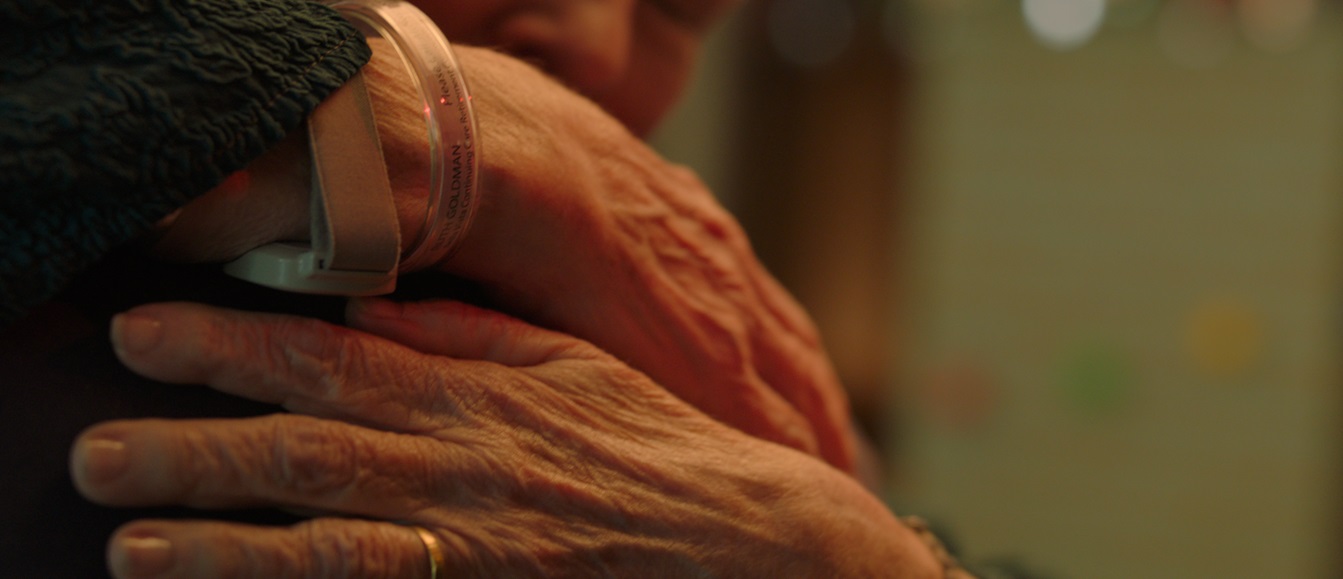LUMI X BFF: Familiar Touch Review
11 November 2024
LUMI Programmer Steven Burrows explores Sarah Friedland's moving debut feature film, Familiar Touch, at Belfast Film Festival.

Upon receiving the ‘Lion of the Future’ award for Familiar Touch, given at Venice International Film Festival for the best first film, Jewish-American director Sarah Friedland chose to speak up in support of Palestinians currently facing a genocide at the hands of the Israeli state. She did not dance around the matter, nor did she restrict her language to cause as little disturbance as possible. She told the truth. This quality of hers shone through then, and it shone just as brightly in her widely-celebrated debut feature.
We open on an elderly woman, Ruth (Kathleen Chalfant), getting dressed. She vibrantly puts together a striking meal, and shortly after a man arrives. The two engage in an awkward yet compelling back and forth. Talk of husbands and wives and fidelity, along with his clear discomfort at Ruth’s verbal and physical suggestions begin to clarify their relationship. Quickly, we realise that this man is her son, Steve, and that Ruth is well into her journey with dementia. Following this exchange, they quietly travel to an assisted living facility, where Steve reluctantly leaves Ruth to her new life and her new home.
There are three moments that set the symbolic tone of Familiar Touch within this opening; her getting dressed, resting her hand on Steve’s knee and him pulling away, and her holding out a hand in the car for Steve to take, only for her to lower it once she realises he will not be taking it. This tone is one of physical and emotional vulnerability without judgement or restraint. This, like the film overall, comes from a rather idealistic place, but it undoes you, softens you, to the point where you want to share the film’s optimism, maturity and gentleness.
Many recent films have sought to study the social and inner impacts of dementia, some with resounding emotional power and authenticity. Haneke’s Amour (2012) and Noé’s Vortex (2021) come to mind. Much of the emotional strength of those works lies in the uncertain, characters unable to understand and change what is happening and the natural fear that comes with that. However, where Friedland splinters off, and ultimately what allows Familiar Touch to be so moving, is how natural everything feels, including fear. The elderly body is visible, respected. Frequently in film this body is displayed as either ugly and undesirable, or childlike and harmless. Here, all its folds, skin and deep wrinkles are normal, presented to us through incredibly still and patient direction. The camera becomes something of a helping hand for the elderly characters in the film to allow their emotions to be fully expressed in ways their minds can no longer do for them, the body relaying to us what the mind can no longer put into words. There is an instance where Ruth is in a pool with the support of an aid, her movements proud and free, her face so calm after everything that has transpired up until that point. It’s incredibly relieving and as much is clear for Ruth as well, because while her mind still falters in this scene, it causes her and her carer no distress, because her body is able to embrace this faltering.
Friedland’s direction, complemented by Chalfant’s exceptional performance, unravels intimacy and desire through this proud use of the body; skin on skin, skin on water, hands, looks, clothing or lack thereof. She acknowledges the importance of the elderly, particularly those with mental or physical disabilities, to be leading normal lives. They aren’t babied nor are they mistreated. They are freely flawed and lived-in, held to the same standards as they were prior to their condition. There are repeated nods to elderly relationships and sex. They gossip and integrate with the carers with little friction, and when their minds begin to slip it isn’t cause for alarm, it’s all about understanding for the director. This being an understanding between the characters, but one that also extends to the spectator. These characters intentionally have little (openly) in common aside from where they are at any given moment. They are often separated by age, role, religion, class, health, sex, race… but again, this works towards Friedland’s thesis of compassion.
There’s an onus on the ‘stranger’ in the film that bleeds into the viewer. Therein lies a responsibility in real life for other people we don’t know that usually goes unacknowledged, and it’s what enables this film to be as compelling as it is. Friedland refrains from giving us a lot of information on the inner lives of these characters, even Ruth has a lot of mystery surrounding her. This approach allows us to appreciate that we don’t have to know people very well to show them love and care and consideration, if know them at all. Spectatorship and observation become tools for compassion. We can see these people at their most exposed, emotionally and physically. We then can recognise these are sides of themselves that are hidden from view in the real world, and perhaps our tenderness will begin to show that bit more. It’s a process that is reflected in Ruth, another way Friedland seeks to level the ground between those with dementia and those without. She is passionate and lively when we meet her, but quickly she becomes confused and agitated and frightened upon being incapable of entirely processing her situation. However, as she becomes acclimated to her surroundings and her carers, and as she is shown just as much kindness and interest as she begins to show the people in the facility, workers and patients alike, then comes the normalcy, the peace. Of course, this is repeatedly challenged by Ruth’s condition, but once more, amidst all the changes and fears, Friedland emphasises that we can handle it, should we make the right choices.
In committing to the portrayal of dementia as a condition that doesn’t have to be wholly debilitating, but rather something that can be treated and worked around through gentleness and action, Friedland reckons with the necessity of mortality and decay. In fact, she brings out the beauty in them, depicting them as the mere acts of nature that they are. In our fear and decay, we can still find solace. For Familiar Touch, loss still comes with comfort and love. We can choose to hold close what they have left us, and will leave us. In our contemporary life, it seems as though no one wants to care for anyone directly outside their sphere of connections and familiarity. Friedland states that this is untrue, that there are people who will choose love without needing justification, and her film urges us to do the same. There is far more binding us than we can see.




